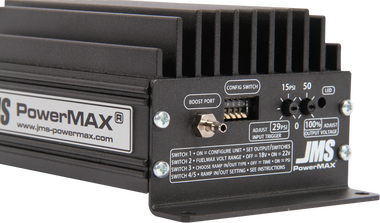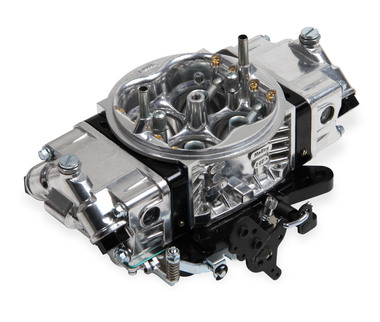Fuel Delivery Upgrades
Increasing engine power requires pumping more air and fuel into the engine. Whether you're getting that air into the motor by increasing displacement, using a different cam or adding forced induction, you need a fuel system that can keep up.
Fuel Tanks
Hard driving, whether going around corners or launching at the drag strip, can
cause fuel to move away from the fuel intake, starving your engine. A fuel cell
can keep the inlet submerged, but if you want to keep a tank in the stock
location, there's another option: Aeromotive's stealth system. Based on the
out-of-production '03-04 Cobra tank, it's been modified to fit a wide range of
models while maintaining Ford's baffle design.
Fuel Pumps

On systems with a return line, any extra fuel pumped into the intake flows back
to the tank, so the pump is always kept flowing at 100%. That means if you put
a bigger pump than you need, all the extra fuel goes back into the tank with no
extra tuning. Ford switched to a returnless system in 1999 models, which uses a
Fuel Pump Driver Module (FPDM) to vary voltage to the pump. This changes the
amount of fuel being moves so there's always just enough on hand to feed the
injectors and needs to be modified to work with different pumps and fuel requirements.
An EFI tuner is needed to use an aftermarket pump with this system.
In-line pumps can be bigger than in-tank pumps. This lets them flow more at the
cost of reliability since they can't dissipate heat through the fuel.
A “boost-a-pump” increases voltage to the pump, making it work past its 100%
duty cycle. This is an easy way to get more fuel out of a stock pump, but where
it really shines is in giving you some breathing room if you're already running
near 100% duty cycle on a forced induction build. The boost-a-pump can kick in
when it reads high manifold pressure, keeping the engine from running lean and
damaging itself. Voltage regulators like the JMS PowerMAX can also be used to
scale fuel pressure with boost pressure readings if you're adding forced
induction.
Fuel Regulator
The regulator controls the amount of fuel entering the fuel rails. On a stock
motor, the pressure regulator is controlled by manifold vacuum and, in the case
of forced induction motors, manifold pressure. This can cause problems if the
motor isn't holding vacuum at idle due to a radical cam profile or the boost
pressure goes beyond what the regulator can handle. Aftermarket regulators are
adjustable and can handle much higher pressures to feed aftermarket fuel rails and
carburetors.
Carburetors

Why replace your car's fuel injection system with a carburetor? They don't have
the fine control of an EFI system, but they're simple to install and tune, and
can save some major wiring headaches when doing an engine swap. They also allow
more options when it comes to intake manifolds. Fuel injection can still be
used with carburetor manifolds by replacing the stock setup with a throttle
body design like the Holley Eliminator or the MSD Atomic. These fit onto
carburetor manifolds and come with ECUs for tuning.
Fuel Injectors
Bigger injectors mean more fuel can be strayed into the intake to match added
fuel from modifications, and that means more power. When changing injectors,
the ECU needs to be modified to match the amount of fuel being sprayed into the
intake with the airflow readings from the MAF sensor. If unmodified, the ECU
will active the new injector for the same duration for a given amount of air as
the stock injector, making the mixture far too rich. Low impedance injectors
use a different signal to activate than the stock high impedance injectors,
requiring a different injector drive for the ECU.
Fuel Rails
When you're using big injectors, flow can be limited by the amount of fuel that
can be delivered through the rails. When switching to larger rails, take into
consideration whether you'll want to run nitrous: many systems are “wet” and
will need a way to tap into the rails to get the fuel that they spray into the
intake alongside the nitrous.
Start Upgrading Your Fuel System Today
Anderson Ford Motorsport has been tuning Mustangs for nearly three decades, so
we know what works. We offer all the parts you need to get your fuel system to
work with your build from the tank to the injectors.
Recent Posts
-
Bringing the Fox Body Mustang into the 21st Century with Holley Terminator X
Anderson Ford Motorsport has been in the Fox Mustang performance industry since 1989. One of the bi …22nd Oct 2021 -
Roush Supercharger install on a 2019 Ford Mustang
Check out this 2019 Ford Mustang before and after we installed a Roush Supercharger. …21st Feb 2020 -
All Blower Installations are not Equal.
Why Should You Choose a Company to Install Your Blower That Has a Dyno Facility In-House?Are all de …24th Jan 2020

